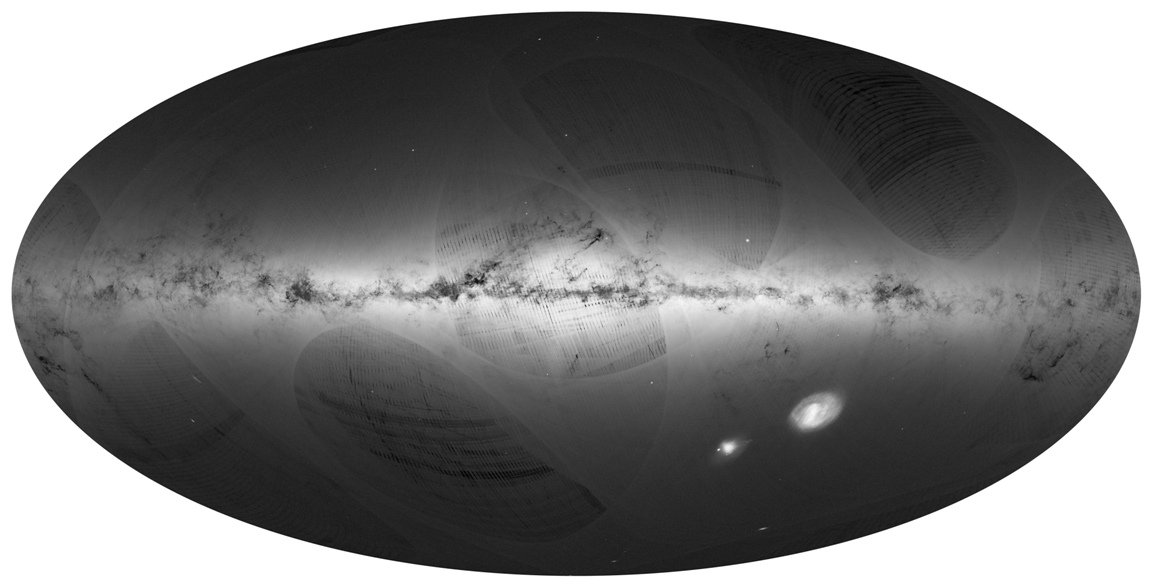Gaia presents the most accurate map of the Universe [NOT TRANSLATED]

This first cartography of Gaia mission, in which there is the participation of a team from the Institute of Cosmos Sciences (IEEC-UB), shows the position of 1.142.69.769 sources, most of them stars of the Milky Way and neighboring galaxies. Gaia also observed the position of extragalactic objects such as quasars and distant galaxies. In addition, it shows in detail the tridimensional position for more than two million stars. This is a giant step to create the map of the universe. The results have been published in the journal Astronomy & Astrophysics.
The most precise map of the Universe
The map has an average precision of 10 mili-arc-seconds, which is similar to the precision of the Hubble Telescope (but this one only covers a small area of the space). Actually, Hubble will use Gaia’s map as a basic cartography to prepare and analyze its observations. Another of the map’s applications is to improve the predictions on the observation of astronomical phenomena, such as eclipses of stars by plants or the Solar System asteroids.
Apart from this big position map, this publication shares distances and movements related to more than two million stars in our closest area (hundreds of light-years) with a precision without precedents which allow astrophysics to analyze the solar environment in three dimensions, opening new windows to stellar physics and the mechanisms of creation and evolution of the stars.
GAIA-GDR1_density_4k-ba
First map of the Univers obtained in Gaia mission. Credit: ESA/Gaia/DPAC
The map shows, for example, the two Magellanic clouds (bottom right side), one of the closest galaxies to the Milky Way. At the left side of the Mini Magellanic Cloud there is a shiny small spot. It is a globular cluster created by hundreds of thousands of stars which have been and still are measured by Gaia.
Other distant galaxies observed by Gaia are Andromeda and M33, located at the bottom left of the Milky Way. Gaia, with a non-precedent precision, is measuring the position of the stars that build these stellar systems, placed at more than two million light-years.
At the central part of the map there is the Milky Way disk. There are irregular and dark structures. They correspond to areas where the star density observed by Gaia is lower due to gas and interstellar dust. This material blocks the light of the distant stars that lie behind.
At a large-scale there can be seen some structures (lines and curves) that respond to the satellite scan law, which defines where the scanning takes place. Therefore, the shiniest areas are the ones that the satellite has seen more over these 14 months. After the 5-year mission these lines will eventually fade out.
Gaia Mission
The Gaia satellite, which was launched in December 2013, is destined to create the most accurate map of the Milky Way. By making accurate measurements of the positions and motions of stars in the Milky Way, it will answer questions about the origin and evolution of our home galaxy.
Over its first two operating years, Gaia obtained 500.000 individual million images and 110.000 million spectrums, more than everything found previously over centuries.
The first data release, containing among other things three-dimensional positions and two-dimensional motions of a subset of two million stars, demonstrates that Gaia’s measurements are as precise as planned, paving the way to create the full map of one billion stars to be released towards the end of 2017.
Participation of the Barcelona team
The team of Institute of Cosmos Sciences (IEEC-UB), led by Professor Jordi Torra, from the Department of Quantum Physics and Astrophysics and Director of the IEEC, has participated in the Gaia mission from the very beginning with an outstanding role: they contributed to its scientific and technologic design, plus the database prototypes and data simulation production during the preparation stages of the mission.
Regarding the first data to be released, the team from Barcelona leads the group that works on the creation of the mission archive. They are also in charge of launching the initial process for the treatment of the data that arrive daily to the satellite, the first step to obtain scientific results such as the ones being published. The team is responsible for the matching of several observations in the same star and collaborates in the calibration of the stars brightness.
It is also worth mentioning that Barcelona is the headquarters of one of the data processing centres of the mission, in which there are Consorci de Serveis Universitaris de Catalunya (Consortium for University Services of Catalonia; CSUC) and Barcelona Supercomupting Center (BSC). This centre provides with the resources to carry out a part of the operations during the mission and it was essential in the preparation and verification tasks, as well as data simulation.
Around twenty scientists and engineers make the Gaia-ICCUB/IEEC team. It is built into the Data Processing and Analysis Consortium (DPAC), which gathers more than 400 people from around twenty European countries.
Further information on ESA’s website. [NOT TRANSLATED]
